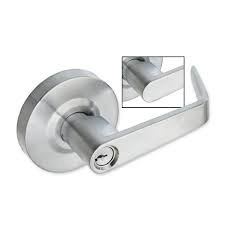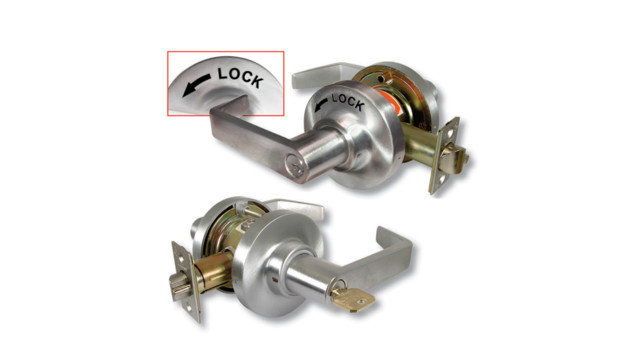As your “one-stop security shop,” we’ve long touted the importance of installing quality commercial lock hardware. The presence of strong locks can go a long way towards combatting crime at your property. We sell and install the best door security equipment on the market. However, properly securing your building goes deeper than simply installing heavy-duty hardware. In addition, we work with customers to choose locks that operate in the desired manner based on their security needs. We refer to the way in which a lock operates as its “function.” In this post, we explain the many options we offer for different high-security door lever functions.
First, we’ll look at a couple types of levers we install that do not require keys to operate. From there, we’ll turn our focus to levers with locking mechanisms requiring the use of keys. The levers discussed in these sections describe the vast majority of all levers we install for our commercial customers. Finally, we’ll take a deep dive into school-specific high-security door lever functions. This area of security gets a lot of attention and care in our industry, and rightly so. Now, let’s get started by seeing how non-key dependent levers can function!
Lever Functions that Operate without Keys
Commercial properties often require workers to pass through many doors on the way to their destinations. Of course, many of these doors should remain secured at least some of the time. However, interior doors often do not require this security. For doors that require no locks at all, we install levers that have no cylinder and, therefore, no locking mechanism. These levers, dubbed “passage” levers, allow anyone to open and close a door at any time.
Of course, not every interior door should provide such easy access. For example, bathroom doors and perhaps even some office doors should allow individuals to lock them from the inside. These levers generally have a button on the inside handle to provide for this operation. We call these levers “privacy” levers. In addition to allowing you to lock them, these levers also prevent accidental lockouts. They do so by automatically “popping” the locking button back into its unlocked position when someone opens the door from the inside. Therefore, these levers provide locking security without the need for keys to operate them. Next up, we’ll move on to a couple functions that do require the use of keys.

This classroom function lever by Marks cannot be locked from the inside, as depicted in the smaller picture of this lever.
Key-Dependent Lever Functions
When our customers want truly secure locks on any door, we generally set them up with one of two types of levers. For starters, “entrance” function levers allow users to lock a door from either side. When standing outside the door, users must lock and unlock the door with a key. From the inside, you can operate a small button or thumbturn to lock the door. Due to fire safety reasons, these levers always allow for door operation from the inside, even when locked. Once unlocked, these levers remain so until someone manually re-locks them.
On the other hand, “storeroom” function levers always require a key to unlock the door from the outside. This proves especially useful for little-used exterior doors that you wish to ensure do not stay inadvertantly unlocked. Similarly to entrance function levers, these levers will always allow those inside to exit freely. However, they do not provide any locking mechanism from the inside, since their purpose is to stay locked at all times. While these levers provide great security, they also occasionally lead to accidental lockouts. After all, anyone who lets the door close behind them without a key can no longer get back through a door secured with a storeroom function lever! Now, let’s shift our attention to a couple high-security door lever functions specific to school security.
School Security Functions
Perhaps no area of commercial lock security receives more attention than school security. After all, violent incidents in schools have risen sharply in the past several years. As Security Magazine recently pointed out, updating security hardware should sit near the top of any school district’s “to-do” list in order to combat this threat. In this section, we’ll look at the two most popular types of levers that we install in classrooms in order to provide the best security possible. Let’s start with a look at the most common of these two, the classroom function lever.
Classroom Function Levers
Classroom function levers attempt to provide a couple types of security. For starters, users can unlock these doors with a key and leave them unlocked, similarly to an entrance function lever. This gives them the security of any keyed lever. However, these levers do not have a button or turn of any kind on the inside. Therefore, someone inside the classroom cannot lock the lever from the inside at all. This keeps students from potentially locking teachers out of the classroom as a prank if teachers enter the hallway for a short amount of time. While this represents an unlikely scenario, it also presents a true security issue if it happens. For this reason, many schools install these types of levers to secure their classrooms.
While useful, classroom security levers do provide a security threat in the case of a security emergency. Because these levers only operate from one side, teachers must get outside of these doors to lock them. In the case of an active shooter or any situation where enterting the hallway could present danger, this obviously creates an undesirable situation. Let’s now see how lock manufacturers address this issue.

This Marks classroom security lever features cylinders on both sides, as well as an indicator to help teachers know their classrooms’ locking status.
Classroom Security Levers
Classroom security levers, sometimes called “Columbine locks,” do require a key to lock and unlock the door at all times, just like a standard classroom function lever. However, classroom security levers also have cylinders on the inside of the lock itself. This lets you lock these doors with a key without putting yourself in harm’s way. Additionally, the fact that you need a key to operate these doors also prevents the student lockout scenario we described earlier. For added security, these levers also generally have an indicator on the inside to help users quickly determine the door’s locking status, and to help them lock the door if needed. You can see this indicator in the pictured classroom security lever. The unique security this function provides makes it one of the most sought-after high-security lever functions in the school security market.
Finding High-Security Door Lever Functions for Your Business
We hope that this post helps you find the high-security door lever functions that help you secure your own business. Additionally, we encourage you to contact us with any questions you may have about the material presented here. We’ve worked with hundreds of businesses to create the ideal lock security for their own unique applications. Moreover, we also invite you to take advantage of our free site survey program. We offer complimentary security audits and equipment quotes for both new and existing customers alike. While on site, we can address any security concerns you may have. Furthermore, we can make suggestions of our own based on our observations of your property.
Perhaps you have a solid foundation of lock harware in place and wish to utilize some of the lever types discussed in this post. Or, maybe reading this has made you realize your lock security may need upgrading. Either way, we are happy to help. Together, we can create a complete security plan, including a series of locks that work the way you want them to, in order to create as much security for your business as possible.
